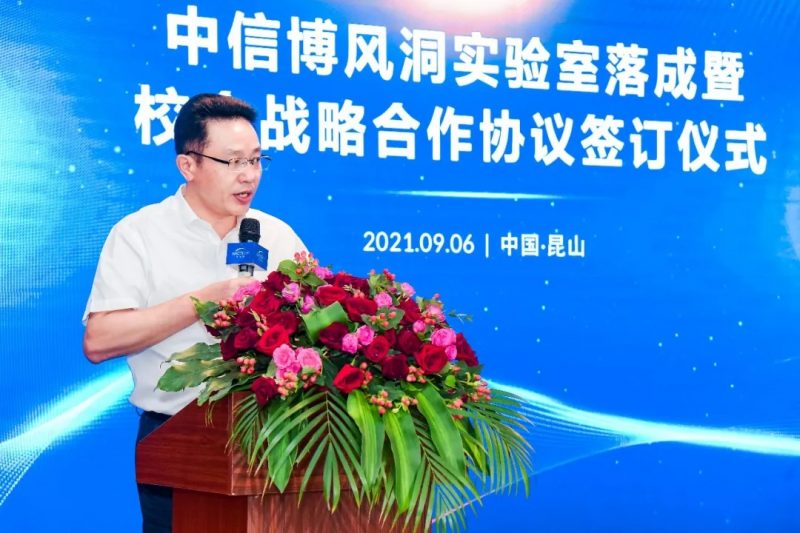PVTIME – China and the global photovoltaic industry are ushering in unprecedented development opportunities in the “dual carbon goal” era where the pursuit of a low-carbon green economy has become the general trend of future global development. At the same time, 182mm and 210mm high-power modules are gradually becoming mainstream in the industry. As a result, matching tracking systems that can greatly reduce the overall LCOE of projects have also seen massive improvements in their application rates.

However, the adaptation of high-power modules also puts forth more stringent requirements on the tracking system. Therefore, in the face of changes in module power and size, the tracking system must undergo more rigorous wind tunnel experiments to ensure system stability to ensure it can truly achieve the “1+1>2” effect of pairing with high-power modules.
On September 6, the inauguration ceremony of the Arctech Wind Tunnel Laboratory was successfully held inside Arctech headquarters in Kunshan, Jiangsu province. With its establishment, Arctech became the world’s first photovoltaic company with a wind tunnel laboratory. The wind tunnel laboratory completed this time has world-leading structural static pressure and structural dynamic response testing capabilities, and can establish core technical data for the company, provide basic design parameters for the company’s product design, and guide product development and product structure design verification.

Cai Hao, Chairman and General Manager of Arctech, said, “As the world’s leading manufacturer and solution provider of photovoltaic tracking brackets, fixed brackets, and BIPV systems, R&D and innovation have always been the core driving force of Arctech. With the mission of enabling technology and leading the development of the industry, we will continue to improve the technological innovation capabilities of our core products so as to serve customers with more stable, reliable, and efficient products and create more value for customers. The completion of the Arctech Wind Tunnel Laboratory is an important step in the process of innovation driven development. In the future, we will continue to empower technology, make progress, and move forward!”

A lot of people often think of tracking brackets as rigid structures when they’re in fact a slender semi-rigid structure. The north-south span of the photovoltaic tracking bracket is relatively large (usually about 30 to 100 meters) and needs to be rotated. It is these structural characteristics that make the spindle of the photovoltaic tracking bracket prone to “vertical bending” and “torsion” deformation. In addition, photovoltaic tracking brackets are mostly installed in open areas with plenty of sunlight and where natural environmental conditions are changeable. Due to this, they are often subjected to external influences such as extremely strong winds, which in turn can lead to a series of problems such as structural instability.
In order to meet the trend of large-size module design, ensure the stable operation of the tracking support, and increase the revenue of photovoltaic power plants, photovoltaic support manufacturers have reached a consensus that wind tunnel experiments are required for calculation verification before support product designs are finalized.
In the past, Arctech has formulated strict design specifications where all structural designs must rely on calculation parameters obtained from wind tunnel tests before finalizing to ensure the safety and stability of products and systems. Today, Arctech became the first to extend the application of wind tunnel experiments to the conceptual design stage and structural design process to promote innovation and accelerate product research and development.
Wang Shitao, Chief Technology Officer of Arctech, said, “For the wind-resistant design of photovoltaic brackets, only reasonable and compliant wind tunnel experiments can accurately obtain the aerodynamic information of the bracket system and ensure the reliability and stability of the bracket system. At the same time, in order to meet the future trend of large-size module design, ensure the stable operation of the support, and improve the revenue of photovoltaic power plants, wind tunnel experiments are more even more indispensable than they were before. We believe that the completion of the Arctech Wind Tunnel Laboratory will not only increase our R&D and innovation capabilities, but also have a far-reaching and positive impact on the development of industry technology, and bolster Arctech’s strength and wisdom when leading the development of the industry.”
In the twelve years since its establishment, Arctech has always insisted on scientific and technological innovation to drive development, and actively promoted the application and transformation of scientific research results. The completion of the wind tunnel laboratory is another example of its commitment to advancing the industry and further solidifies the company’s position as a leader of the industry.











